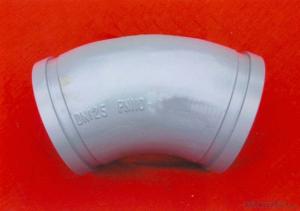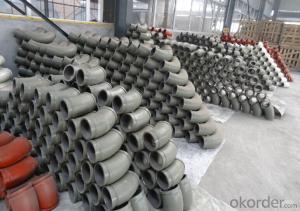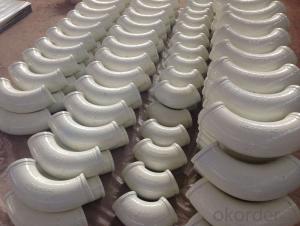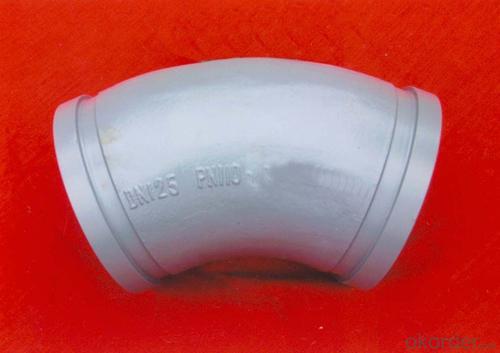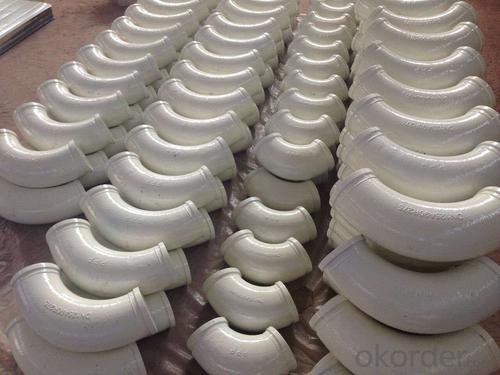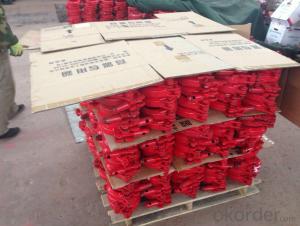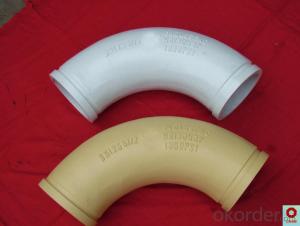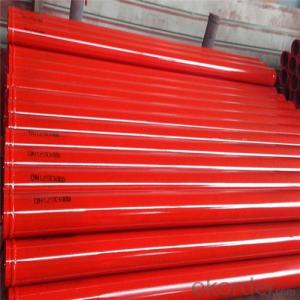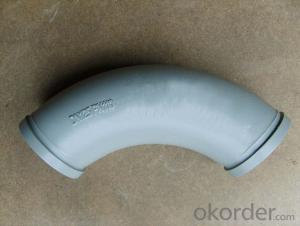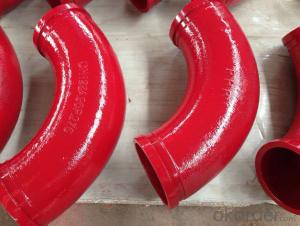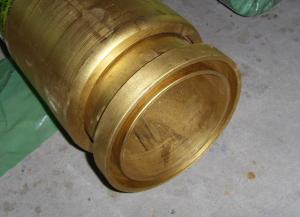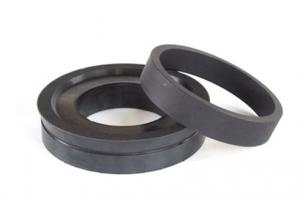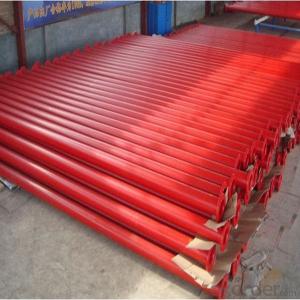CONCRETE DELIVERY ELBOW SCHWING TYPE 45DEG R275 DN125
- Loading Port:
- Tianjin
- Payment Terms:
- TT OR LC
- Min Order Qty:
- 100 pc
- Supply Capability:
- 10000 pc/month
OKorder Service Pledge
OKorder Financial Service
You Might Also Like
concrete pump elbow table
Wear-resistant Single or Double Concrete Pump Elbow | |||||||
Type | Singe Elbow | Double Elbow | |||||
Model | DN125 | DN150 | DN175 | DN125 | |||
Material | Casting Steel ,ST52 | Inside | 40Cr | Outside | |||
Size | R275*90° | R275*90°+110 | 36° | F2000 | R275*90° | R275*90°+110 | |
R275*45° | R275*90°+211 | R400*30° | A3000 | R275*45° | R275*90°+211 | ||
R275*25° | R275*90°+411 | R400*45° | 471B | R275*25° | R275*90°+411 | ||
R275*20° | R275*90°+424 | R400*30° | 571B | R275*20° | R275*90°+424 | ||
R275*15° | R275*45°+170 | R488*90° | A1000 | R275*15° | R275*45°+170 | ||
R180*90° | R275*45°+310 | R500*90 | C1000 | R180*90° | R275*45°+310 | ||
R232*60° | R275*45°+310 | R280*90° | B2000 | R232*60° | R275*45°+310 | ||
R240*36° | 20°Lengthen | R240*36° | 20°Lengthen | ||||
R240*30° | 25°+740 | R240*30° | 25°+740 | ||||
R240*15° | 40°Zoomlion | R240*15° | 40°Zoomlion | ||||
R385*29° | R385*29° | ||||||
R315*33° | R315*33° | ||||||
Technic | Forged | ||||||
Average life | 25,000cubic | 50,000cubic | |||||
Appliciation | Used in concrete transport in construction work | ||||||
1.product profile:The double layer concrete pump elbow is developed by ourselves through new
technology and process.
2.characteristic:the inner layer of this concrete pump elbow undergoes heat treatment,and then the rigitiry can reach 62-65HRC.
3.characteristic:the outer layer of the concrete pump elbow possess good toughness properties
to protect the inner layer,so the security of the elbow is improved.
4.life:the experiment done abroad shows that the life of our concrete pump elbow can reach 35000-50000cbm,got the customers' praise
5.Beside the double layer concrete pump elbow,we produce all kinds of concrete pump parts,
straight pipe hose flange coupling and so on.
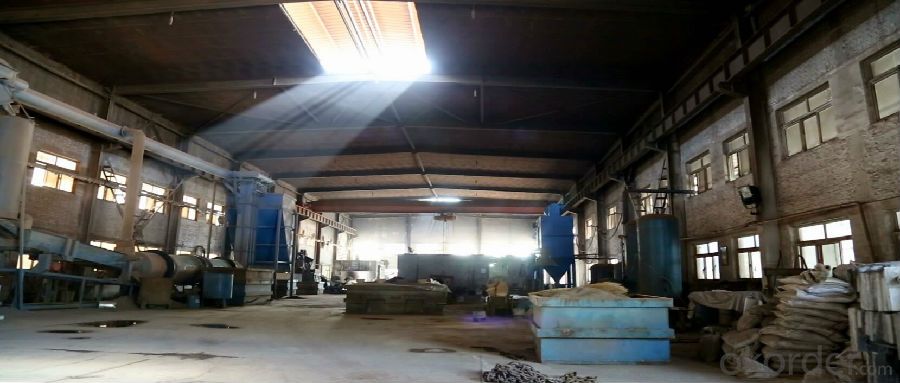
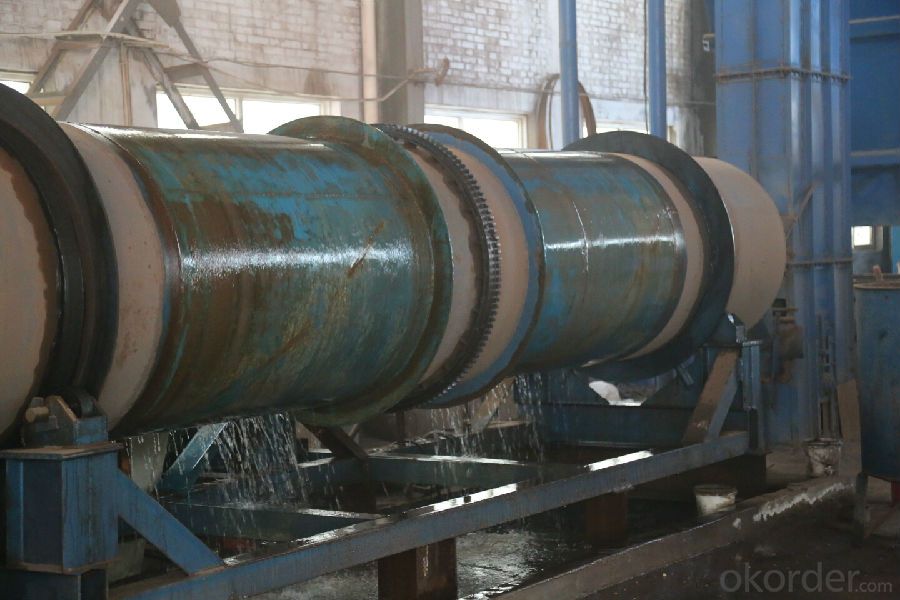
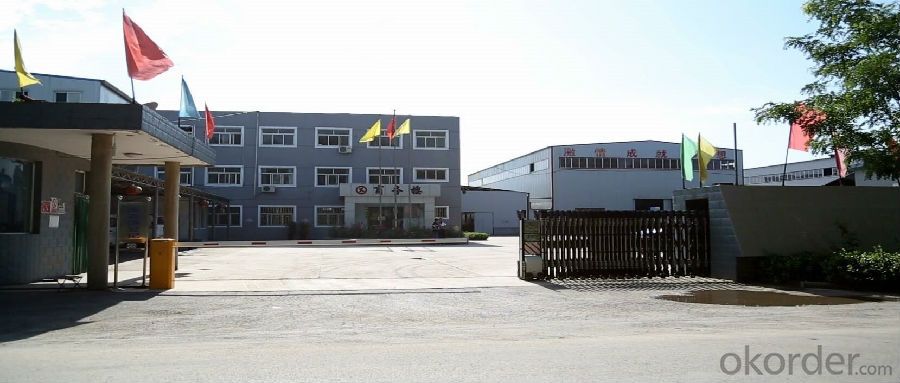
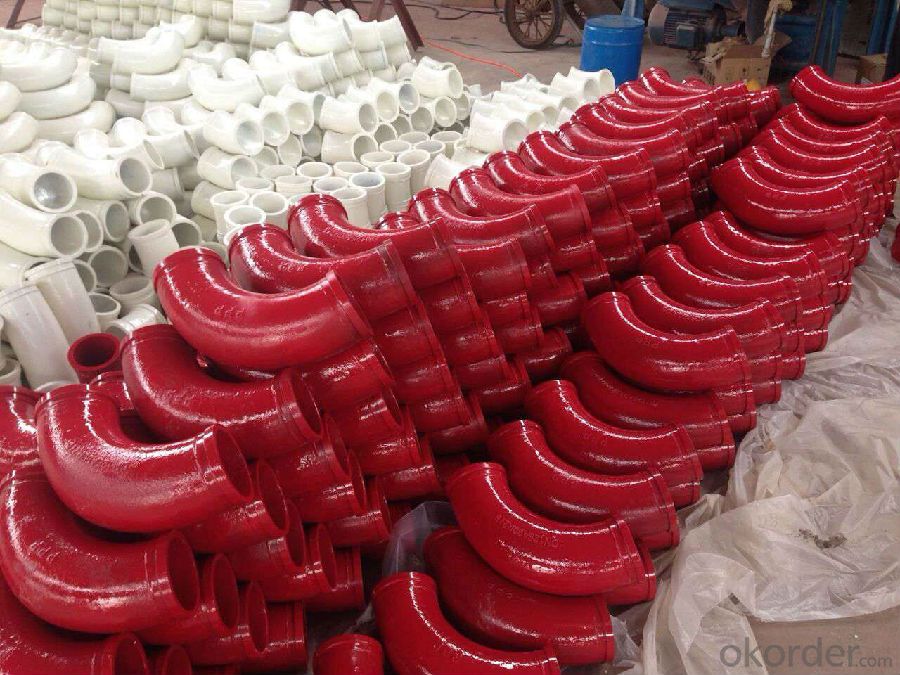
- Q: Are there any special tools required for replacing concrete pump spare parts?
- Yes, there are special tools required for replacing concrete pump spare parts. These tools may include wrenches, screwdrivers, hydraulic jacks, cranes or hoists, and specific equipment for removing and installing components such as seals, bearings, or pistons. Additionally, some specialized tasks may require the use of a welding machine or cutting tools. It is important to have the right tools to ensure a safe and efficient replacement process.
- Q: Are there any specific guidelines for the installation of hopper components or agitators in concrete pump spare parts?
- Yes, there are specific guidelines for the installation of hopper components or agitators in concrete pump spare parts. These guidelines are designed to ensure proper functioning and safety of the equipment. Here are some of the key guidelines to follow: 1. Read the manufacturer's instructions: It is important to carefully read and understand the manufacturer's instructions for installing hopper components or agitators. These instructions will provide specific details and steps for installation. 2. Use proper tools and equipment: Make sure to use the appropriate tools and equipment as recommended by the manufacturer. This includes using the right size wrenches, bolts, and other necessary tools for the installation process. 3. Ensure a clean and level surface: Before installing the hopper components or agitators, ensure that the surface is clean and level. This will help in proper alignment and functioning of the parts. 4. Check for any damages or defects: Before installation, thoroughly inspect the hopper components or agitators for any damages or defects. If any issues are found, it is important to address them before proceeding with the installation. 5. Follow proper alignment and positioning: Follow the manufacturer's recommendations for aligning and positioning the hopper components or agitators. Improper alignment can lead to malfunctioning or premature wear of the parts. 6. Securely fasten all connections: Ensure that all connections, such as bolts, nuts, and clamps, are securely fastened as per the manufacturer's instructions. Loose connections can cause accidents or damage to the equipment. 7. Test the equipment: After installation, it is important to test the equipment to ensure proper functioning. Follow the manufacturer's guidelines for testing and make any necessary adjustments if required. 8. Regular maintenance and inspection: Once the hopper components or agitators are installed, it is essential to regularly inspect and maintain them. This includes cleaning, lubricating, and replacing any worn-out parts as per the manufacturer's recommendations. By following these guidelines, you can ensure that the installation of hopper components or agitators in concrete pump spare parts is done correctly, promoting efficient operation and prolonging the lifespan of the equipment.
- Q: How often should concrete pump hydraulic motors be inspected and replaced?
- Concrete pump hydraulic motors should be inspected regularly, ideally every 500 to 1000 hours of operation, to ensure they are in good working condition. However, the frequency of replacement depends on various factors such as usage intensity, maintenance practices, and the quality of the motor. Generally, hydraulic motors can last for several years if properly maintained, but if any signs of wear, leakage, or reduced performance are observed, it is recommended to replace them promptly to prevent potential breakdowns or accidents.
- Q: Are there any warranties or guarantees available for concrete pump spare parts?
- Concrete pump spare parts come with warranties and guarantees to ensure their quality and performance. Various manufacturers and suppliers provide these warranties, which typically cover defects in materials or workmanship. The coverage period usually ranges from a few months to a year or more. Furthermore, some suppliers offer guarantees on the performance or durability of their spare parts, providing customers with reassurance. To ensure your protection in case of any issues, it is advisable to inquire about the specific warranty or guarantee terms before purchasing concrete pump spare parts.
- Q: How often should hopper cylinder seals be replaced in a concrete pump?
- The replacement frequency of hopper cylinder seals in a concrete pump varies depending on factors such as seal quality, usage intensity, and maintenance practices. It is recommended to regularly inspect hopper cylinder seals for any signs of wear or damage, and if cracks, tears, or leaks are visible, immediate replacement is advised to prevent further damage to the concrete pump. In general, hopper cylinder seals can last for several months to a couple of years, depending on the aforementioned factors. However, it is crucial to establish a preventive maintenance plan and regularly monitor the seals' condition to ensure optimal performance and minimize downtime. Furthermore, consulting the manufacturer's guidelines or seeking advice from a professional concrete pump technician is advisable to determine the specific replacement interval for hopper cylinder seals based on the pump model, usage patterns, and environmental conditions.
- Q: Can concrete pump spare parts be purchased online?
- Yes, concrete pump spare parts can be purchased online. There are various online platforms and websites that specialize in selling construction equipment and spare parts, including concrete pump spare parts. These online stores offer a wide range of options and brands, allowing customers to browse and select the specific spare parts they need for their concrete pump. Additionally, online purchasing provides the convenience of comparing prices, reading customer reviews, and having the spare parts delivered to your doorstep. However, it is essential to ensure the authenticity and reliability of the online store before making a purchase to ensure that you are getting genuine and high-quality spare parts.
- Q: How can one determine the correct voltage and current rating for electrical components in concrete pump spare parts?
- To determine the correct voltage and current rating for electrical components in concrete pump spare parts, several factors need to be considered. Firstly, it is essential to consult the manufacturer's specifications and documentation for the concrete pump and its spare parts. These documents usually provide detailed information about the voltage and current requirements for each electrical component. Paying close attention to these guidelines ensures that the components are operated within their designed parameters. Secondly, it is crucial to understand the electrical system and its requirements. This involves analyzing the power supply available at the site where the concrete pump will be used. Factors such as the voltage level (e.g., 110V, 220V, 440V) and frequency (e.g., 50Hz, 60Hz) of the electrical supply need to be taken into account. Additionally, the maximum current capacity of the electrical system must be considered to prevent overload situations. Furthermore, it is advisable to assess the specific application and operating conditions of the concrete pump. Different components may have varying voltage and current requirements depending on their function and the environment in which they are used. For instance, components installed in outdoor areas may require higher voltage ratings to withstand harsh weather conditions. Lastly, seeking professional assistance from qualified electricians or engineers is highly recommended. They possess the expertise and knowledge to accurately determine the voltage and current ratings for electrical components in concrete pump spare parts. Their experience allows them to consider various factors such as safety regulations, compatibility with the existing electrical system, and any specific requirements of the concrete pump manufacturer. By taking into account the manufacturer's specifications, understanding the electrical system, considering the application and operating conditions, and seeking professional advice, one can effectively determine the correct voltage and current rating for electrical components in concrete pump spare parts.
- Q: How do I troubleshoot common problems with concrete pump spare parts?
- To troubleshoot common issues with concrete pump spare parts, it is important to approach the task systematically. Here are a few steps that can assist you in identifying and resolving problems: 1. Start by observing the symptoms and pinpointing the specific problem you are facing. These may include leaks, reduced pumping efficiency, abnormal noise, or power failure. 2. Examine the pump's hoses, pipes, and valves for any clogs or blockages that may impede the flow of concrete. Remove any debris or obstructions you come across. 3. Inspect the wear parts, such as the pump's pistons, seals, or gaskets, for signs of wear and tear, cracks, or damage. Replace any worn-out components when necessary. 4. Check for any air leaks that may affect the pump's performance. Inspect the fittings, connections, and seals for signs of air leakage. Tighten loose fittings or replace faulty seals as required. 5. Ensure that the lubrication system is functioning properly. Lack of lubrication can cause friction and damage to the pump's moving parts. Add lubricant if needed. 6. Verify the electrical connections if you encounter power failure or electrical problems. Look for loose or damaged wires and connections. Repair or replace any faulty components. 7. Consult the manufacturer's manual for valuable troubleshooting information specific to your concrete pump spare parts. Refer to the manual to understand the recommended maintenance procedures and troubleshooting steps. 8. If you are unable to identify or resolve the issue on your own, it is advisable to seek professional assistance. Contact a qualified technician or the manufacturer's customer support for further guidance and support. Always remember that regular maintenance and proper usage of concrete pump spare parts can help minimize the occurrence of problems.
- Q: What are the precautions for gas washing of concrete pump?
- Subsection blowing, should first blow off near the discharge end of a pipe, then has blown the empty tubes connected with not purged during the purge, the remaining part.
- Q: Can concrete pump spare parts be tested for compatibility with different types of concrete mixes?
- Yes, concrete pump spare parts can be tested for compatibility with different types of concrete mixes. The compatibility of these spare parts with different types of concrete mixes is important to ensure the efficiency and effectiveness of the concrete pumping process. Concrete pump spare parts such as pipes, hoses, and valves are designed to handle specific pressures, flow rates, and types of concrete mixes. Testing these spare parts for compatibility involves subjecting them to various concrete mix compositions, including different aggregate sizes, cement types, and admixtures. This testing helps determine if the spare parts can withstand the specific characteristics and properties of different concrete mixes. The compatibility testing process involves evaluating factors such as the durability of the spare parts, their resistance to abrasion and corrosion, and their ability to handle the specific pumping requirements of different concrete mixes. This testing can be conducted in laboratory settings or on-site, depending on the specific needs and requirements of the project. By testing concrete pump spare parts for compatibility with different types of concrete mixes, potential issues such as clogging, wear and tear, or reduced performance can be identified and addressed beforehand. This ensures smoother and more efficient concrete pumping operations, minimizing downtime and improving overall productivity. It is worth noting that manufacturers of concrete pump spare parts often provide technical specifications and guidelines for their products, including information on the compatibility with different types of concrete mixes. Following these guidelines and conducting compatibility testing can help ensure the optimal performance and longevity of the spare parts, leading to successful concrete pumping operations.
Send your message to us
CONCRETE DELIVERY ELBOW SCHWING TYPE 45DEG R275 DN125
- Loading Port:
- Tianjin
- Payment Terms:
- TT OR LC
- Min Order Qty:
- 100 pc
- Supply Capability:
- 10000 pc/month
OKorder Service Pledge
OKorder Financial Service
Similar products
Hot products
Hot Searches
Related keywords
